
 |
|
TO PAGE: 1 • 2 • 3 • 4 • 5 • 6 • 7 • 8 • 9 • 10 • 11 • 12 • 13 • 14 • 15 |
![]()
ELLERY QUEEN MYSTERY MAGAZINE (3)
| The magazine not only has a rich history it was also published monthly in English, French, Italian, German, Portuguese, Spanish, Japanese,... and Dutch. An overview! | |
| During World War II (1944 - 1946), issues of Ellery Queen's Mystery Magazine were distributed to American forces with either "Special Edition for the Armed Forces Overseas" or with "Overseas Edition for the Armed Services" printed on the cover. They were not allowed to include the advertisements from the US editions, the opening 3 pages were typically replaced with an additional story, or sometimes an additional puzzle added at the end. |
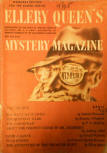 |
| An Australian reprint edition was available between July 1947 and November 1964. "Registered in Australia for transmission through the Post as a Periodical" by special arrangement between Mercury Publication Inc. New York, N.Y. USA. and the publishers Consolidated Press Ltd. Sydney (Printed by Compress Printing Ltd. Sydney Australia). According to one 1954 newspaper article it sold 18,720,000 copies since publication began in 1947. |
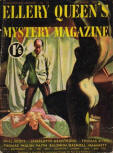 |
| In the UK, EQMM got his own reprint edition. It was published, with the same name, by Mellifont Press. Starting February 1953 it ran until the September 1964 issue. |
 |
|
Ellery Queen
Mystère Magazine or
Mystère Magazine for short was the title by which the
magazine was sold in the French Language. Hence prices for France, Switzerland and
Belgium were included on the covers. It published 343 issues between 1948 and
October 1976 by Editions OPTA, Paris which also published Alfred Hitchcock
magazine from 1961 until 1975. Georges Rieben is best known as the founder, in 1972, of the "Le Prix Mystère de la critique", a prize awarded to this day to the best French and foreign detective story. In December 1969, Georges Rieben, together with three friends, was asked to take over from Maurice Renault who was then in charge of Ellery Queen Mystère Magazine. Renault had been seriously ill for several years and the magazine's sales suffered. The three friends were, Luc Geslin (film photographer), Jean-Claude Guilbert (writer, journalist), and Bernard Rapp (television and film). Soon only Luc Geslin was left, who took over as editor, his task mainly consisted of selecting the short stories and having them translated, if necessary. Under Rieben's impulse, Mystère Magazine revived for a short time. After Daniel Domange, the director of the OPTA publishing house, died in a plane crash in 1971, the company came under poor management and was eventually liquidated in December 1981. By then Mystère Magazine already released its last issue in October 1976. Together with Luc Geslin, Rieben tried to make a new start with Magazine du Mystère (Editions Trega, Toulouse). Without the collaboration of EQMM, an attempt was made, at least visually, to give the impression that this magazine was a continuation of Mystère Magazine (see 2 pictures in the middle below). It turned out to be in vain, according to Rieben mainly due to a lack of professional distribution service, as this initiative ended after publication of its 12th issue (which were published between Nov/Dec 1976 and 1978). In December 1981 the first issue of what was to become the second series of Mystère Magazine Ellery Queen (Editions D'Iéna, Paris) was published with Luc Geslin as editor-in-chief and Marc Bourgès-Maunoury as director. George Rieben was part of the editorial team. It is the only known issue of this series... |
|
 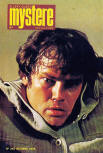 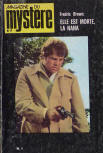 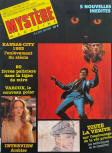 |
|
|
Italian readers got to read the periodical in two
versions, one by Garzanti called
I Gialli di Ellery Queen
(1950 - 1956) the other
La
Rivista di Ellery Queen (1956 - 1957)
by Mondadori and was a full supplement (containing articles and short
stories) to Il Gialli Mondadori, an Italian series of mystery/crime
novels. After 1957 it became the name of a shorter supplement with the same
name was provided in each book published weekly(!) in the series Il
Gialli Mondadori. This publisher also had other Ellery Queen related publications such as Ellery Queen Presenta, an anthology published four times a year). Mondadori still actively publishes Ellery Queen novels each year! |
|
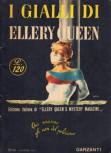 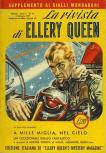 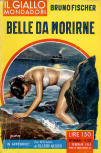 |
|
Several incarnations in the German language. As
early as 1949 six issues were published by Panther (Lausanne) under the
name MM Detektiv. Distribution in
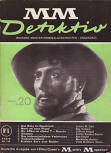 Germany was done by the book and
magazine publisher Reinhold M. Sauerwein from Frankfurt am Main. Five years
later Aufwärts Verlag from Berlin dared to try again and as of June 1954
it resulted in seven issues of
Ellery Queen's Kriminal Magazin. Germany was done by the book and
magazine publisher Reinhold M. Sauerwein from Frankfurt am Main. Five years
later Aufwärts Verlag from Berlin dared to try again and as of June 1954
it resulted in seven issues of
Ellery Queen's Kriminal Magazin. As of 1961 Wilhelm Heyne Verlag from Müninch published a selection of EQMM issues in pocket format, at first as a part of their general series of publications later as a spin-off. After a few years in 1966 Heyne finally decided to give the American Digest format a try, which resulted in thirteen issues. Between 1967 and 1992 Heyne published 100 pocketbook format issues of Ellery Queen's Kriminal Magazin al numbered (sadly the numbers interfere with their regular numbering of Ellery Queen novels...) |
|
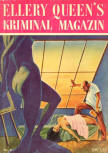  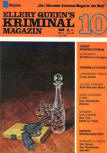  |
|
|
The Portuguese version was mainly read in Brazil. Since it launch in May 1949 it was published monthly by Revista do Globo S. A., in Porto Alegre under the name Misterio Magazine. Later it was retitled to Mistério Magazine de Ellery Queen and Ellery Queen Misterio Magazine in 1974 it's last year of publication. |
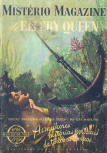 |
| In 1962-63 eight issues of the Finnish magazine Ellery Queenin jännityslukemisto were published by Gummerus. In the following years several other attempts were published Maailman parhaat jännärit (1971), Ellery Queens valitut jännärit (1977) and Ellery Queen Jännityksen Mestari (1988-1991). Each one, sadly, with limited success. In 2000 publisher Gummerus surprised us with a re-issue of their first EQMM issues (1963 series). |
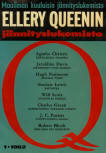 |
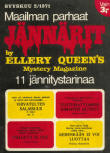 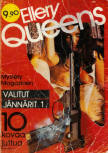 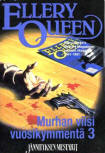 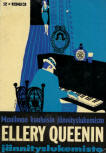 |
|
| Kroki Krimi (1/1988 - 10/1990) a very unusual sounding EQMM incarnation in Hungarian. It also contained selected stories from Alfred Hitchock Mystery Magazine. |
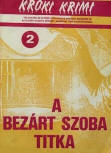 |
| The Greek edition Περιοδικό Έλλερυ Κουήν was published for the first time by Dioptra (ΔΙΟΠΤΡΑ) with Thanos Tataris (Θάνο Τάταρη) as publisher and Giannis Karastathis (Γιάννη Καραστάθη) as editor in May 1983. It was published every 15th of the month. It continued it's run, at least until January 1984. |
 |
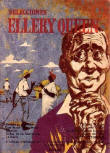 Editions
in the Spanish language are found the world over. The Chilean version was published
in 1953 under the name Selecciones Ellery Queen
by Zig-Zag (Santiago de Chile). Sometimes referred to as Selecciones
Ellery Queen de Crimen y Misterio.
(1953 - 1954) it was published after an agreement
with
Mercury. It made the American stories more accessible and later also
introduced Latin American authors. This magazine seems to have failed in
the function of stimulating other writers to produce police fictions;
ostensibly because the contractual terms with the American editor of the
magazine required that only stories that appeared in the original
English edition be used. Editions
in the Spanish language are found the world over. The Chilean version was published
in 1953 under the name Selecciones Ellery Queen
by Zig-Zag (Santiago de Chile). Sometimes referred to as Selecciones
Ellery Queen de Crimen y Misterio.
(1953 - 1954) it was published after an agreement
with
Mercury. It made the American stories more accessible and later also
introduced Latin American authors. This magazine seems to have failed in
the function of stimulating other writers to produce police fictions;
ostensibly because the contractual terms with the American editor of the
magazine required that only stories that appeared in the original
English edition be used. |
|
| The Mexican edition by Editores Novaro (San Bartolo Naucalpan) was called Coleccion de Misterio Ellery Queen. (1955 - 1957). It had a circulation of 20,000 copies and finished printing on December 30. 1957. Initially it only had original EQMM stories in it, but also introduced a competition for aspiring writers, thus introducing Mexican stories, which both in numbers and quality, far exceeded their expectations and eventually led to a new periodical called Aventura y Misterio (Originales en Castellano) (1955). |
 |
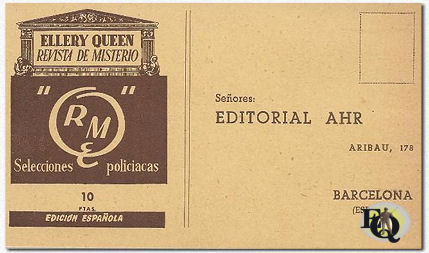 |
|
|
The Spanish edition of
EQMM was first published under the name
Ellery Queen
Revista de Misterio in
1954 by Editorial Ahr-Aribau from Barcelona. M.Y.N.E. s.a. (Barcelona) published Mystery Magazine (Ellery Queen's) from 1963 until December 1968. This time subtitled as "la revista de misterio mas leída del mundo" M.Y.N.E. s.a. also provided a Spanish version of AHMM. It also worked together with EQMM to regularly publish anthologies (Antologia...) |
|
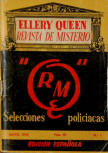 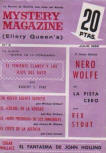 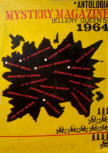 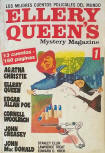 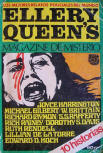 |
|
|
Edited by Martin Renaud and printed monthly in Argentina the Spanish
edition, simply called Ellery Queen's Mystery Magazine
(Los Mejores Cuentos
Policiales Del Mundo) started
in December 1975, although ambitious at 160 pages and 30000
copies (!) the attempt by Ed. Orion ended with it's eleventh publication in October
1976. Reportedly it's final editions were renamed Ellery
Queen's Crimen y Misterio. Finally publisher Aura (Barcelona) provided us with the 70s entry called Ellery Queen's Magazine de Misterio (Los Mejores Relatos Policiales Del Mundo) (1976 - 1977). |
|
|
|
|
| Världsdeckaren was published in Sweden (Stockholm) in 1952 - 1954. It had very distinctive lovely artwork on front and back by Olle Eksell, Fritjof Pedersén and Per Silfverhjelm. |
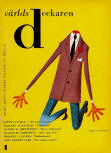 |
|
In 1968-1969 a second attempt was made by Hemmets Journal (Malmö) under the name Ellery Queen's Kriminal Pocket it published at least 10 issues. |
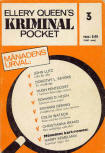 |
| This attempt also appeared in Norway in almost identical form, both in appearance and content, under the title Ellery Queen's Krim Magasin, 6 issues in 1968 and 3 in 1969. The publisher was A/S Hjemmet - forlagsavdelingen (which would later merge with Egmont). |
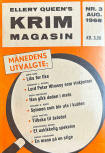 |
| Finally, this same initiative was also repeated in Denmark, again with largely the same features, but under the title Ellery Queen's Krimi Magasin (1968 - 1969). It was published as a digest and publisher Egmont delivered 10 issues, 7 in 1968 and 3 in 1969. |
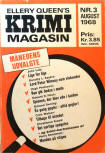 |
|
The magazine was continued 1969 by Forlaget Spektrum
under the title
Ellery Queen Kriminalmagasin
(1969 - 1971). It became an independent subseries of "Spektrums Pocket Books" (Spektrums Pocketbøger). At least 21 issues of this appeared; all in uniform format and layout and with about 128 pages. The format was changed to the more usual pocket book format of about 11.5 x 18 cm. The table of contents is on the back cover. The color of the "Q" and the back cover are the same and vary from issue to issue. |
 |
| エラリイクイーンズミステリマガジン or EQMM was the first Japanese incarnation of the famous magazine. It was published by Tor Books between July 1956 and 1965. In July 1959 (N°37) the winner of a short-story contest was published. After this issue it became more common to include stories by Japanese authors. |
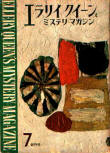 |
| As of January 1966 the magazine was re-titled ハヤ��ワ・ミステリマガジン or Hayakawa Mystery Magazine. It held on to the contractual relation with EQMM until 1977. Despite this it did maintain a partial focus on foreign authors. In 2006 it celebrated it's 50th birthday. As of May 2015 it was published every two months. |
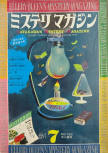 |
| The July 2019 edition of Hayakawa Mystery Magazine brought a fitting tribute to the writers duo that gave us Ellery Queen. The two cousins Manfred B. Lee and Fred Dannay graced the front page of the magazine that featured the article "The Reintroduction of Ellery Queen". | |